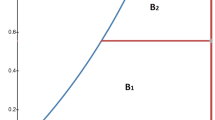Abstract
The literature on the tragedy of the anticommons typically suggests that producers of complementary goods should integrate themselves. Recent decisions by the antitrust authorities seem however to indicate that there exists a tradeoff between the “tragedy” and the lack of competition characterizing an integrated market structure. In this paper we analyze such tradeoff in oligopolistic complementary markets when products are vertically differentiated. We show that quality leadership plays a crucial role. When there is a quality leader, forcing divestitures or prohibiting mergers, thus increasing competition, lowers prices and enhances consumer surplus. However, when quality leadership is shared, “disintegrating” firms may lead to higher prices. In this case, concerns about the tragedy of the anticommons are well posed in antitrust decisions.
Similar content being viewed by others
References
Alvisi M, Carbonara E (2010) Imperfect substitutes for perfect complements: solving the anticommons problem. Department of Economics working paper n.708/June 2010. University of Bologna
Alvisi M, Carbonara E, Dari-Mattiacci G, Parisi F (2009) Complementing substitutes: bundling, compatibility and entry. Amsterdam Center for Law & Economics working paper no. 2009-10
Buchanan J, Yoon YJ (2000) Symmetric tragedies: commons and anticommons. J Law Econ 43: 1–13
Casadesus-Masanell R, Nalebuff B, Yoffie D (2007) Competing complements. Harvard Business School working paper n.09-009
Chen MK, Nalebuff B (2006) One-way essential complements. Cowles Foundation discussion paper no.1588
Choi JP (2008) Mergers with bundling in complementary markets. J Ind Econ 56(3): 553–577
Cournot A (1838) Recherches sur les Principes Mathematiques de la Theorie des Richesses, Hachette, Paris (English translation by NT Bacon published in Economic Classics [Macmillan, 1897] and reprinted in 1960 by Augustus M. Kelly)
Dari-Mattiacci G, Parisi F (2007) Substituting complements. J Competition Law Econ 2(3): 333–347
Denicolò V (2000) Compatibility and bundling with generalist and specialist firms. J Ind Econ 48(2): 177–187
Economides N (1989) Desirability of compatibility in the absence of network externalities. Am Econ Rev 79: 1165–1181
Economides N, Salop SC (1992) Competition and integration among complements, and network market structure. J Ind Econ 40(1): 104–123
Einhorn MA (1992) Mix and match compatibility with vertical product dimension. RAND J Econ 23(4): 535–547
Gabszewicz JJ, Thisse JF (1979) Price competition, quality and income disparities. J Econ Theory 20: 340–359
Gans JS, King SP (2006) Paying for loyalty: product bundling in oligopoly. J Ind Econ 54(1): 43–62
Heller M (1998) The tragedy of the anticommons: property in the transition from Marx to markets. Harvard Law Review 111(3): 621–688
Matutes C, Regibeau P (1988) “Mix and Match”: product compatibility without network externalities. RAND J Econ 19(2): 221–233
Matutes C, Regibeau P (1992) Compatibility and bundling of complementary goods in a duopoly. J Ind Econ 40: 37–53
Motta M (2003) Competition Policy. Theory and practice. Cambridge University Press, New York
Motta M, Vasconcelos H (2005) Efficiency gains and myopic antitrust authority in a dynamic merger game. Int J Ind Organ 23(9–10): 777–801
Nalebuff B (2004) Bundling as an entry barrier. Q J Econ 1: 159–187
Parisi F, Schulz N, Depoorter B (2005) Duality in property: commons and anticommons. Int Rev Law Econ 25(4): 578–591
Parker GG, Van Alstyne MW (2005) Two-sided network effects: a theory of information product design. Manag Sci 51(10): 1494–1504
Peitz M (2008) Bundling may blockade entry. Int J Ind Organ 26: 41–58
Shapiro C, Varian H (1999) Information rules. A strategic guide to the network economy. Harvard Business School Press, Boston
Author information
Authors and Affiliations
Corresponding author
Rights and permissions
About this article
Cite this article
Alvisi, M., Carbonara, E. & Parisi, F. Separating complements: the effects of competition and quality leadership. J Econ 103, 107–131 (2011). https://doi.org/10.1007/s00712-010-0184-6
Received:
Accepted:
Published:
Issue Date:
DOI: https://doi.org/10.1007/s00712-010-0184-6




